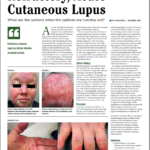In total, the module includes more than 100 images, with more than 70% representing images from the photographic libraries of the creators and with a specific focus on representation of patients with a wide range of skin tones. The average learner in the pilot study, which included internal medicine residents and rheumatology fellows, was able to complete the entire module in 45 minutes and reported increased self-assessed competence in achieving the module’s objectives.
Dr. Zickuhr and Dr. Goglin hope to expand the use of the module to trainees in internal medicine and rheumatology across the U.S. to assess its effectiveness and, ultimately, help improve the recognition of cutaneous lupus findings in patients with skin of color.
In Sum
The session, like the journal club format and online learning module described, was fun, engaging and enlightening with respect to how educators can use best practices in teaching the fellows of today to become the highly skilled clinicians of tomorrow.
Jason Liebowitz, MD, completed his fellowship in rheumatology at Johns Hopkins University, Baltimore, where he also earned his medical degree. He is currently in practice with Skylands Medical Group, N.J.
References
- Strait A, Graf J, Margaretten M, et al. Race, ethnicity and disparities in rheumatology educational materials. Arthritis Care Res (Hoboken). 2021 Mar 25. Online ahead of print.
- Rana A, Witt A, Jones H, et al. The representation of skin colors in images of patients with lupus erythematosus. Arthritis Care Res (Hoboken). 2021 May 31. Online ahead of print.
- Kannuthurai V, Murray J, Chen L, Baker EA, Zickuhr L. Health care practitioners’ confidence assessing lupus-related rashes in patients of color. Lupus. 2021 Oct;30(12):1998-2002.
More Pearls
In addition to the programs discussed here, several other teaching pearls were selected for presentation in poster format.
Journal Club for Untraditional Topics
“Certain aspects of training involve less data, but are still amenable to a targeted journal club discussion,” said Don Kimpel, MD, University of Virginia, Charlottesville.
“Physicians are commonly stoic about personally difficult patients, but ignoring these feelings can contribute to poor patient care and burnout,” said Dr. Kimpel. “Noting these frustrations in faculty and trainees, we created a special journal club designed to open communication and help reduce this restraint.
“In 1978, the New England Journal of Medicine published ‘Taking Care of the Hateful Patient’ by James Groves. Although the title is at first jarring, the first sentence defines the term and provides a springboard for valuable discussion,” continued Dr. Kimpel. “After reading the article, we reflect on the stereotypical patients the author describes and discuss examples from our own experiences. We usually define other types of patients and situations more pertinent to the current practice of medicine, such as the too frequent electronic communicator, which did not exist in Dr. Groves’ era.”


